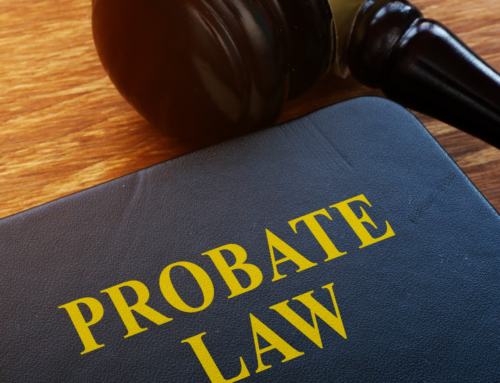January 2022
Many people create revocable probate avoidance type trusts and then mistakenly believe that they do not need to again look their estate planning documents until a crisis arises. Unfortunately, it may then be too late to avoid expensive steps to correct the issues that may have developed in the meantime. A very common issue has come up in my practice that underscores the need for married couples to revisit their estate planning documents and ensure that they are drafted with the current estate tax rules in mind:
Prior to 2015, the vast majority married couples’ living trusts in the United States involved a requirement to fund what I will refer to as a ‘decedent’s trust.’ That is a generic term to describe an irrevocable sub-trust that comes into existence after the first spouse’s death, and which is designed to hold that spouse’s interest in the couple’s community property along with his or her separate property, up to the dollar amount of the then-existing estate tax exemption amount, in trust for the remaining portion of the surviving spouse’s lifetime. In drafting married couples’ trusts, different attorneys have called this irrevocable sub-trust by different names, such as: Credit Shelter Trust, Unified Credit Trust, Bypass Trust, B Trust, or Marital Trust. I use the generic term ‘decedent’s trust’ to avoid confusion when so many different terms are used to describe the same concept. I use the term ‘sub-trust’ because the decedent’s trust is a trust that is set forth within the terms and provisions of a married couple’s revocable living trust, and only comes into existence upon the death of the first spouse. I refer to a married couple’s living trust with a decedent’s trust funding requirement as an ‘A-B Trust.’
The reason that so many trusts were drafted this way was to minimize the imposition of the federal estate tax. Here’s how it worked: Take, for example, that a married couple has a community property estate that was worth $1,200,000 in 1995, they had no estate planning documents in place and the husband dies. The Federal Estate Tax Exemption Amount in effect from 1987-1997 was $600,000. Because the entire estate is community property, the surviving wife will inherit the deceased spouse’s interest in the estate (worth $600,000). Her estate is then worth $1,200,000. Then she dies in 1997. The first $600,000 of her estate was not subject to estate tax because the exemption amount was $600,000. However, the next $600,000 of her estate was over the Exemption Amount and hence, was subject to estate tax at the then existing rate of 55%. 55% of $600,000 yielded a tax bill of $330,000. Ouch!
So, the solution to that problem was for the married couple in this hypothetical to create a revocable living trust that set forth a decedent’s trust funding requirement. i.e. the A-B Trust. If this married couple had an A-B Trust in place, as soon as reasonably practical after the husband’s death, the surviving wife would hire a Trust and Estate attorney to help her transfer assets to the decedent’s trust. That process is known as ‘funding’ the decedent’s trust.
Because the decedent’s trust is irrevocable, and the surviving wife does not have the outright power to amend that trust, the assets held in that trust are deemed to be distinct from the surviving wife’s personal assets. In other words, the IRS views the decedent’s trust assets as not being owned by the surviving wife, or, as we say, not within her ‘taxable estate.’ The resulting effect was that the assets in the decedent’s trust were not subject to estate tax.
The decedent’s trust, by its terms, provides all of its net income to the surviving spouse in quarterly or more frequent installments. The surviving spouse has the right to invade the principal of the trust for ‘health, education, maintenance and support,’ (frequently called ‘the HEMS standard’). The HEMS standard essentially meant that the surviving spouse could use the assets of the decedent’s trust to maintain the same standard of living before the death of the deceased spouse.
In our hypothetical, the surviving wife transferred $600,000 worth of assets to the decedent’s trust, and the remaining $600,000 of assets are deemed to be in the ‘survivor’s trust.’ The survivor’s trust is fully amendable by the surviving spouse and within the complete control of the surviving spouse, without a HEMS standard.
Upon the death of the surviving wife, the $600,000 that was funded to the decedent’s trust would be distributed to the trust’s beneficiaries (commonly the couple’s children) without any estate tax consequence. Further, her half of the estate (the survivor’s trust) which in our hypothetical was also worth $600,000, also passed to the trust’s beneficiaries without any estate tax. Hence the proper usage of the A-B Trust saved this family $330,000 of estate tax! Because of the effectiveness of this technique, prior to 2015, most married couples opted to create an A-B trust for the purpose of probate avoidance and minimization of estate tax.
However, decedent’s trusts have their dark side. The task of funding the decedent’s trust, when done with the advice of experienced counsel (as, in the drafter’s opinion, is necessary to get the job done properly) frequently resulted in attorney fees in excess of $5,000. Then, a Federal Form 1041 Fiduciary Income Tax return is required to be filed for so long as the decedent’s trust is in existence. The decedent’s trust, by design, exists for the rest of the surviving spouse’s life. Hence, the surviving spouse was not only required to file a Federal Form 1040 personal income tax return, but also a Fiduciary Income Tax return for the rest of his/her life. The 1041 preparation and filing is much better handled by a tax professional, and the cost of that return is commonly in excess of $2,000 per year. Further, if the decedent’s trust was funded with a principal residence, the surviving spouse lost the mortgage interest deduction on his/her personal income tax returns.
While none of those factors are what one would consider to be desirable, the worst aspect of the administration of decedent’s trusts is that the assets held therein do not qualify for a Step-Up in Capital Gains Tax Basis upon the surviving spouse’s death. The Capital Gains Tax Basis for assets such as stocks and real estate is, in essence, the purchase price of the asset. If the asset appreciates in value, and the owner sells the asset at a value higher than that at which it was purchased, the difference between the purchase price and the sale price is taxable Capital Gain. If, however, the owner dies while still owning that asset that has appreciated in value, the Capital Gains Tax Basis ‘steps up’ to the fair market value of the asset as of the date of the owner’s death. If the owner’s heirs and beneficiaries then sell the asset, they are not subject to any Capital Gains Tax on the difference between the original purchase price of the asset and the date of death valuation.
Returning to our hypothetical example above, let’s assume that on the deceased husband’s death in 1995 the surviving wife funds the decedent’s trust with community property real estate that was worth $600,000. Let’s further assume that the surviving wife subsequently died in 2015. Because the real estate was community property, the Capital Gain Tax Basis of the real estate stepped up to fair market value as of the date of the husbands passing. So, it’s fair market value in 1995 was $600,000, and its then-new Capital Gains Tax Basis was also $600,000. Let’s further assume that the real estate doubled in value between 1995 and 2015 to $1,200,000. If that real estate was held in the decedent’s trust, the couples’ children would inherit that real estate with a Capital Gains Basis of $600,000. If they then sold it at $1,200,000, their taxable Capital Gains would be $600,000. The combined Federal and California State tax for long term Capital Gains is approximately 25%, which would yield a Capital Gains tax bill in the amount of $150,000. That hurts too.
If that real property were held in the survivor’s trust (i.e. not in the decedent’s trust) it would have stepped up again to fair market value upon the surviving wife’s death in 2015. If that real estate was then sold subsequent to the wife’s death at date of death valuation, there would be no capital gains tax whatsoever. While decedent’s trusts worked great to minimize Estate Tax, they also came with both administrative costs and Capital Gains tax issues.
Congress changed the estate tax rules in 2015. One of the more significant changes was to create what we call ‘Exemption Portability.’ The whole reason why A-B Trusts were drafted was to hold the deceased spouse’s interest in the estate, up to the then existing Estate Tax Exemption Amount, in an entity that was regarded as separate and distinct from the estate of the surviving spouse. In that manner, the IRS could not charge estate tax on the deceased spouses’ portion of the estate. The concept of Exemption Portability is that instead of funding a decedent’s trust to protect the deceased spouse’s half of the estate from estate tax, the surviving spouse has the option of filing a Federal Form 706 Estate Tax Return to claim the deceased spouse’s estate tax exemption. The Federal Estate Tax Exemption amount in 2015 was $5,250,000. Hence for deaths occurring in 2015, upon the death of the deceased spouse, the surviving spouse could elect to receive the deceased spouse’s exemption amount, which would result in the surviving spouse having a total estate tax exemption amount of $10,500,000. The result was that a married couple could pass an estate worth $10,500,000 to their heirs and beneficiaries without triggering any estate tax, and without the need to fund a decedent’s trust.
Hence, the concept of Exemption Portability obviated the need to use A-B trusts to minimize estate tax. This was a revolutionary development in the world of estate planning, and seen as a tremendous benefit for married couples with estates in excess of $5,000,000.
While all of us in the world of Trusts and Estates love the idea of Exemption Portability, the question that immediately came up in response to that development was what effect would that have on the vast numbers of married couples’ A-B trusts that had been signed prior to 2015?
Well, for starters, even if the surviving spouse failed to fund the decedent’s trust, so long as the trust says that the decedent’s trust is supposed to be funded, the IRS will treat the estate as if the decedent’s trust had been funded for capital gains tax purposes. Simply not funding the decedent’s trust is NOT a solution to the problem.
The answer is that the married couple that had created an A-B Trust is best advised to schedule an appointment with their estate planning attorney and review their trust. Usually we ‘restate’ the trust, meaning that we amend the trust in its entirety to create an entirely new trust document to remove the obligation to fund a decedent’s trust on the first spouse’s death. Fortunately, we do not need to change the title to any of the trust’s assets upon doing so.
If a married couple had an A-B Trust and one of the spouses has already passed away, but the other spouse is surviving and has mental capacity, we can restate the trust, and transfer any assets from the decedent’s trust to the survivor’s trust, upon written consent of the trust’s beneficiaries.
If both spouses have passed away while the A-B Trust was still their operative trust document, we can file a Petition in our local probate court to reform the trust and remove the requirement to fund the decedent’s trust. We can do this both in cases where the decedent’s trust had been funded, and in cases where the requirement exists, but the surviving spouse failed to fund the decedent’s trust. Although that Petition and related legal proceedings are costly, they are much less expensive than the Capital Gains Tax obligations that can frequently arise when the decedent’s trust funding requirement has not been removed from the married couple’s trust.
However, none of those remedial steps can be addressed without the review of the estate planning documents by a qualified Trust and Estate attorney. If you haven’t done so already, please contact your attorney and schedule an appointment to review your estate planning documents. It could literally save your family many thousands of dollars.
![]()





